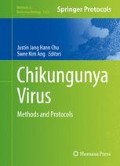Abstract
The limitations of high-throughput genomic methods used for studying virus–host interactions make it difficult to directly obtain insights on virus pathogenesis. In this chapter, the central steps of a protein structure similarity based computational approach used to predict the host interactors of Chikungunya virus are explained by highlighting the important aspects that need to be considered. Identification of such conserved set of putative interactions that allow the virus to take control of the host has the potential to deepen our understanding of the virus-specific remodeling processes of the host cell and illuminate new arenas of disease intervention.
Access this chapter
Tax calculation will be finalised at checkout
Purchases are for personal use only
References
Friedel CC (2013) Computational analysis of viral-host interactome. In: Bailer SM, Leiber D (eds) Virus-host interactions: methods and protocols, methods in molecular biology, 1st edn. Springer, New York, pp 115–130
Shoemaker BA, Panchenko AR (2007) Deciphering protein-protein interactions. Part ii. Computational methods to predict protein and domain interaction partners. PLoS Comput Biol 3(4):e43
Aloy P, Russell RB (2003) InterPreTS: protein interaction prediction through tertiary structure. Bioinformatics 19(1):161–162
Lu L, Lu H, Skolnick J (2002) MULTIPROSPECTOR: an algorithm for the prediction of protein-protein interactions by multimeric threading. Proteins 49:350–364
Davis FP, Braberg H, Shen MY et al (2006) Protein complex compositions predicted by structural similarity. Nucleic Acids Res 34:2943–2952
Tastan O, Qi Y, Carbonell JG, Klein-Seetharaman J (2009) Prediction of interactions between HIV-1 and human proteins by information integration. Pac Symp Biocomput 14:516–527
Evans P, Dampier W, Ungar L et al (2009) Prediction of HIV-1 virus host protein interactions using virus and host sequence motif. BMC Med Genomics 2:27–39
Doolittle JM, Gomez SM (2010) Structural similarity-based predictions of protein interactions between HIV-1 and Homo sapiens. Virol J 7:82–96
Davis FP, Barkan DT, Eswar N et al (2007) Host-pathogen protein interactions predicted by comparative modeling. Protein Sci 16(12):2585–2596
Franzosa EA, Xia Y (2011) Structural principles within the human-virus protein-protein interaction network. Proc Natl Acad Sci U S A 108(26):10538–10543
Zhang QC, Petrey D, Deng L et al (2012) Structure based prediction of protein-protein interactions on a genome wide scale. Nature 490:556–561
Doolittle JM, Gomez SM (2011) Mapping protein interactions between Dengue virus and its human and insect hosts. PLoS Negl Trop Dis 5(2):e954
Rajasekharan S, Rana J, Gulati S et al (2013) Predicting the host protein interactors of Chandipura virus using a structural similarity-based approach. FEMS Pathog Dis 69(1):29–35
Sreejith R, Rana J, Dudha N et al (2012) Mapping of interactions among Chikungunya virus nonstructural proteins. Virus Res 169(1):231–236
Dudha N, Rana J, Rajasekharan S et al (2014) Host-pathogen interactome analysis of Chikungunya virus envelope proteins E1 and E2. Virus Genes 50(2):200–209. doi:10.1007/s11262-014-1161-x
Berman HM, Westbrook J, Feng Z et al (2000) The Protein Data Bank. Nucleic Acids Res 28:235–242
Zhang Y (2008) I-TASSER server for protein 3D structure prediction. BMC Bioinformatics 9:40–47
Dudha N, Appaiahgari MB, Bharati K et al (2012) Molecular cloning and characterization of Chikungunya virus genes from Indian isolate of 2006 outbreak. J Pharm Res 5(7):3860–3863
Mishra GR, Suresh M, Kumaran K et al (2006) Human protein reference database—2006 update. Nucleic Acids Res 34:D411–D414
Stark C, Breitkreutz BJ, Reguly T et al (2006) BioGRID: a general repository for interaction datasets. Nucleic Acids Res 34:D535–D539
Szklarczyk D, Franceschini A, Kuhn M et al (2011) The STRING database in 2011: functional interaction networks of proteins globally integrated and scored. Nucleic Acids Res 39:D561–D568
Aranda B, Achuthan P, Alam-Faruque Y et al (2009) The IntAct molecular interaction database in 2010. Nucleic Acids Res 38:D525–D531
Crosby MA, Goodman JL, Strelets VB et al (2006) FlyBase: genomes by the dozen. Nucleic Acids Res 35:D486–D491
McCarthy F, Wang N, Magee GB et al (2006) AgBase: a functional genomics resource for agriculture. BMC Genomics 7:229–241
Ashburner M, Ball CA, Blake JA et al (2000) Gene ontology: tool for the unification of biology. Nat Genet 25:25–29
Dennis G, Sherman B, Hosack D et al (2003) DAVID: database for annotation, visualization, and integrated discovery. Genome Biol 4:P3
Huang DW, Sherman BT, Lempicki RA (2009) Systematic and integrative analysis of large gene lists using DAVID bioinformatics resources. Nat Protoc 4:44–57
Matthews L, Gopinath G, Gillespie M et al (2009) Reactome knowledgebase of human biological pathways and processes. Nucleic Acids Res 37:D619–D622
Shannon P, Markiel A, Ozier O et al (2003) Cytoscape: a software environment for integrated models of biomolecular interaction networks. Genome Res 13:2498–2504
Rana J, Sreejith R, Gulati S et al (2013) Deciphering the host-pathogen interface in Chikungunya virus-mediated sickness. Arch Virol 158(6):1159–1172
Author information
Authors and Affiliations
Corresponding author
Editor information
Editors and Affiliations
Rights and permissions
Copyright information
© 2016 Springer Science+Business Media New York
About this protocol
Cite this protocol
Rajasekharan, S., Gupta, S. (2016). Bioinformatics Based Approaches to Study Virus–Host Interactions During Chikungunya Virus Infection. In: Chu, J., Ang, S. (eds) Chikungunya Virus. Methods in Molecular Biology, vol 1426. Humana Press, New York, NY. https://doi.org/10.1007/978-1-4939-3618-2_17
Download citation
DOI: https://doi.org/10.1007/978-1-4939-3618-2_17
Published:
Publisher Name: Humana Press, New York, NY
Print ISBN: 978-1-4939-3616-8
Online ISBN: 978-1-4939-3618-2
eBook Packages: Springer Protocols

